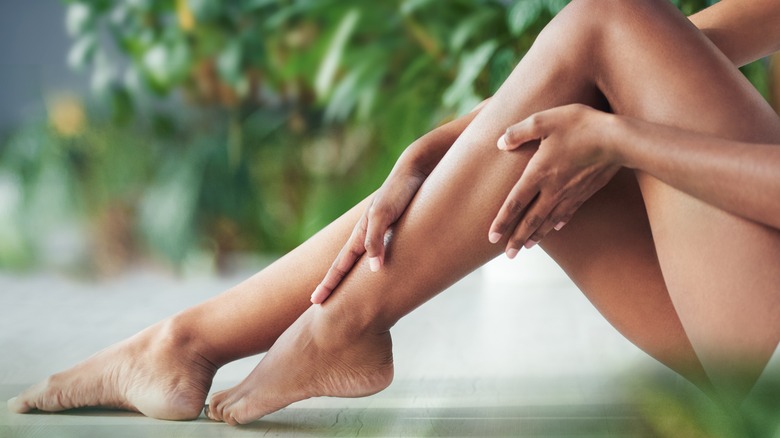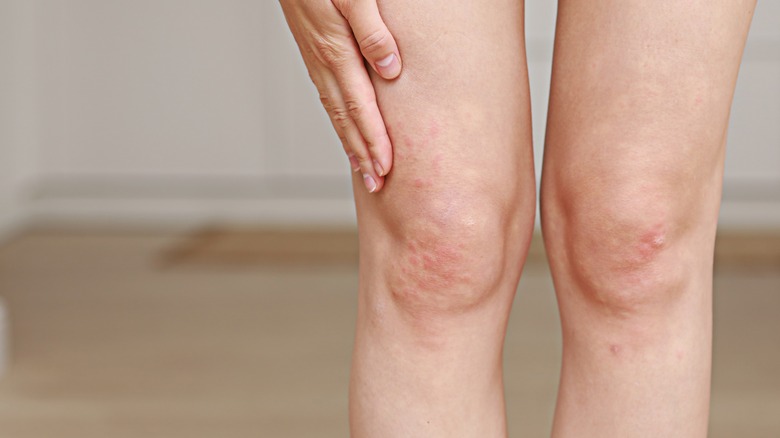If You Get Acne On Your Legs, This Could Be Why
Hormonal, cystic, or just plain random, acne comes in many forms. According to the American Academy of Dermatology, a staggering "85% of people between the ages of 12 and 24" experience the skin condition in some form, making pimples not only common, but expected. In fact, acne is the eighth most common disease in the world, per PubMed. So, if you struggle with blemishes, rest assured that you're far from alone.
In recent years, the acne positivity movement on Instagram has taken over. The hashtag is about embracing blemishes and natural skin texture. As explained by consultant dermatologist Dr. Anjali Mahto (via The Independent) in 2018, "Skin positivity is about confidence, self-love and reducing the stigma and shame that can be associated with visible skin conditions such as acne, scarring, or birthmarks to name a few." Celebrities, too, have made their stance on the movement clear. In December 2020, Keke Palmer posted a series of no make-up selfies highlighting her acne. "To all the people struggling with this please know you're not alone," she captioned the photos. Products like brightly-colored pimple patches have also become popular since the emergence of the social media-led #acnepositivity movement.
Though acne most commonly pops up on the face, back, and chest (areas with the most oil production), pimples can also form on your legs. Keep in mind, however, these blemishes often form for different reasons entirely.
Your razor could be the culprit
Chances are those bumps on your legs aren't actually pimples. Really, they're probably a result of inflamed hair particles, known specifically as folliculitis. According to board-certified dermatologist Annie Chiu via Byrdie, "Folliculitis presents as small red bumps or white-headed pimples. The bumps tend to center around leg hairs—even the thinnest ones can be inflamed." But, what causes folliculitis? Your shaving techniques, wearing tight clothing, and sweat can all result in these acne-like protrusions, per Medical News Today. Also, don't underestimate the power of soaking in a dirty hot tub.
If you experience painful ingrown hairs after shaving or waxing, it's probably because bacteria has infected your follicles. Fortunately, switching up your hair removal techniques (or following Emma Watson's ingrown hair advice) could solve these leg pimples. Mayo Clinic recommends washing your legs with a gentle facial cleanser before you're about shave your legs. This will ensure that the area is clean, preventing possible bacterial or fungal infections. It's also important to make sure you're using some sort of shaving lotion (or even your own hair conditioner) throughout the process (via Healthline).
Exfoliating before shaving will raise ingrown hair to the surface, preventing folliculitis as well. Always remember to shave in the same direction as hair growth, use a sharp and clean blade, and moisturize after you're done. If you can help, try not to shave or wax too frequently — frequent hair removal will result in irritation.
Don't pick at acne on your legs
Keratosis pilaris — patches of rough, red bumps that sometimes appear arms and legs — can also look like acne. However, this condition is actually a result of keratin plugging-up hair follicles (via Healthline). Though keratosis pilaris isn't preventable (it's often genetic in nature), it usually disappears by the end of your 20s.
As is the case with hormonal or cystic acne, it's best not to pick at or pop bumps on your legs whatever their cause. Digging into or picking at skin can result in infection or result in long-term scarring. According to board-certified dermatologist Dendy Engelman, M.D. (via Men's Health), "Popping anything causes your skin to physically break apart, making it more susceptible to infection and an even bigger problem than what was originally there in the first place." When it comes to keratosis pilaris, specifically, a chemical exfoliant made with salicylic acid can often work wonders.


